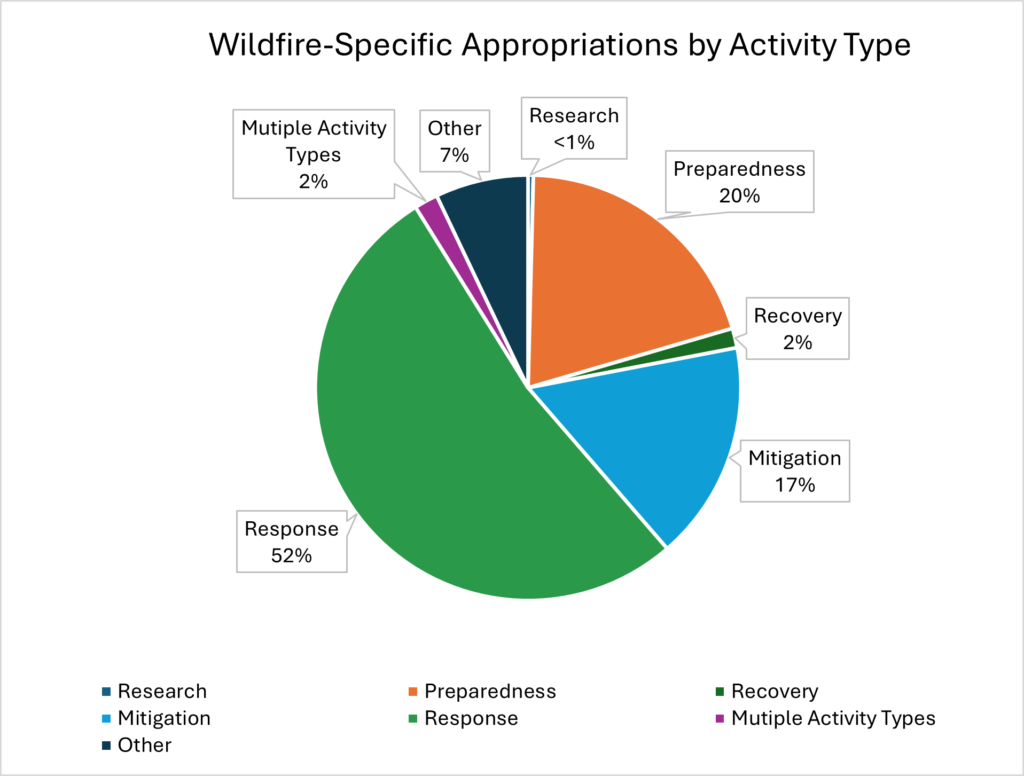Topline Analysis for the Wildfire Spending Database: FY2015-2024
Federal spending data, including the decision-making processes behind that spending, should be clear and comprehensive across the entire federal government. Transparency is essential in evaluating the priorities and effectiveness of these expenditures, including how taxpayer dollars are distributed geographically, across which activities, and over what timeframes. Agencies need to improve their transparency in disclosing how these funds are being deployed and inform taxpayers and policymakers about the obstacles and successes encountered.
The goal of this database is to educate policymakers, practitioners, and the public on how taxpayer dollars have been used to address the wildfire crisis, identify gaps in our understanding of wildfire appropriations, and provide insights and recommendations to ensure federal funding is directed where it will be most efficient and effective in protecting communities.
Wildfire-Specific Appropriations
Between FY2015 and FY2024, including supplemental appropriations for future years made through the Infrastructure Investment and Jobs Act (IIJA), TCS catalogued $59.7 billion in appropriations for programs or line items that directly address wildfire.

More than half of these appropriations were allocated to wildfire response activities, with another 20 percent directed toward preparing for future wildfire events. Wildfire response, primarily suppression, is a major driver of federal expenditures on wildfire. The U.S. Forest Service (USFS) and Department of the Interior (DOI) reserve funds for suppression efforts—through the FLAME Wildfire Suppression Reserve Fund and the Wildfire Suppression Operations Reserve Fund—account for 24 percent of all wildfire-specific appropriations catalogued in this database.
Risk mitigation activities have consistently been recognized as critical for reducing federal wildfire costs, yet they have not received the necessary investments to safeguard against rising future expenses. Mitigation activities account for 17 percent of the wildfire-specific appropriations catalogued here. However, as noted, while appropriations for mitigation activities are intended to reduce the risk or impacts of wildfires, it remains unclear to what extent these funds directly contribute to effective mitigation. Programs and line items funded under hazardous fuels reduction need to be closely scrutinized and carefully evaluated using outcome-oriented metrics. Furthermore, programs created to address the lack of commercial viability in forest and wood products may create perverse incentives that undercut forest health objectives, potentially increasing wildfire risk.
Wildfire-Adjacent Appropriations
This database also catalogues 88 programs and line items, totaling $897 billion in appropriations ($875 billion in unique appropriations as the database includes some line items within another listed program), for programs that may, but do not necessarily, fund wildfire-related activities. These include programs we believe impact wildfire behavior (e.g., forest health and general forest management) or address wildfires within broader mandates, such as natural disaster programs like Building Resilient Infrastructure and Communities (BRIC) Program, or disaster-related initiatives like the Defense Community Infrastructure Pilot (DCIP) that may fund wildfire-related activities, even if they do not prioritize them.
Many of these programs lack publicly available information on wildfire-specific spending. Developing wildfire budget crosscuts could clarify federal spending trends. An effective budget crosscut should provide granular data on wildfire-specific spending within broader climate mitigation or disaster recovery programs, presenting a comprehensive overview of federal wildfire investments. A crosscut that compiles data from multiple agencies over time, categorized by types of wildfire activities and geographical regions, could illuminate and compare activities targeting similar goals across agencies.
Missing Appropriations
Several programs and line items in the database lack complete appropriations data. As budget watchdogs with decades of experience, we have extensively searched bills, agency budget requests, and other government and non-governmental sources for appropriations information. A label of “Not Available” on a program page for a fiscal year (or a blank cell in the regular appropriations column on the main table) does not necessarily mean the information isn’t publicly available, but it clearly indicates that it is not easily accessible. Our inclusion of federal wildfire-adjacent programs with limited publicly available appropriations information highlights the need to address the gaps in our current understanding of federal wildfire expenditures.
